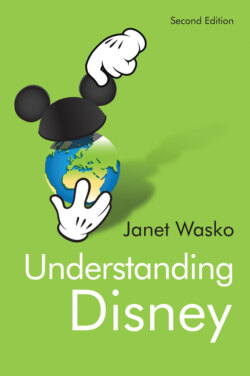Читать книгу Understanding Disney - Janet Wasko - Страница 11
Why another book (and a second edition) on Disney?
ОглавлениеDespite all of the attention and analysis, there is still a need to look at the entire Disney phenomenon from a critical perspective.5 This is especially important in light of the intensification of Disney’s corporate power during the last few decades and its increasingly dominant role in the media/entertainment industry. This book will look at the wide range of perspectives that have been used – and must be used – to understand the Disney Multiverse. The company’s continued expansion and ongoing popularity calls for the deliberate integration of political economic analysis with insights drawn from cultural analysis and audience studies or reception analysis, or, in other words, analysis emphasizing the economic as well as the ideological, or production as well as consumption. In the case of Disney, this approach is expressed in the notion of manufacturing fantasy.
If we are to fully understand the Disney phenomenon, the reception or consumption of Disney products needs to be considered. Though some analysts have attempted to integrate audience responses and reception with textual readings, most of the analyses of Disney texts merely reinforce the subjective nature of these readings. Also, by focusing only on individual texts, the overall output or ideological position represented by Disney is neglected. Herbert Schiller expressed this idea many years ago:
Just as the Disney management finds it profitable to use a systems approach to sell its products, the best way to understand the message it is selling is to adopt a systems analysis approach to the product – that is, to take the Disney machine as an entity, and to examine its many outputs as elements in a totality with some common features.6
Schiller’s call for a “systems approach” echoes the aim of this book, which is to present an integrated approach to understanding Disney. In other words, the analysis of production, distribution, and consumption of Disney texts is necessary to understand their significance. An integrated approach is especially relevant in considering the Disney theme parks, which present Disney ideologies in material form, providing sites of pleasure, fun, and family entertainment but also serving as highly successful businesses.
In 1997, David Buckingham discussed several books on the Disney phenomenon, pointing out how the studies included economic, textual, and (sometimes) audience research, albeit rarely integrating these forms of analysis. He noted: “Of course, it would be asking too much to expect any single book to incorporate all these dimensions.”7 It is even more of a challenge to examine the “whole” of Disney since the turn of the century, with the extensive expansion of the Disney corporation and the continuous academic and popular attention it receives. However, this book still represents an attempt to look at the Disney Multiverse from a systems perspective and contribute to further understanding its significance. Although every detail cannot be discussed thoroughly, an integrated, interdisciplinary approach can help us to further understand the popularity of Disney over the years, as well as Disney’s role as a major contributor to consumer culture in the United States and around the world.
In chapter 2, different versions of Disney’s history will be discussed, as well as the issue of Walt Disney’s contribution to the company’s development. A political economic analysis of the different sectors of the current Disney empire will be presented in chapter 3, followed by a discussion of the company’s strategies and policies in chapter 4. Chapter 5 will review examples of the analysis of Disney content, and chapter 6 will consider how some of the same techniques have been applied to the Disney theme parks. Chapter 7 will discuss the reception of Disney by different types of audiences or Disney fans, as well as presenting examples of how individuals respond to Disney.
